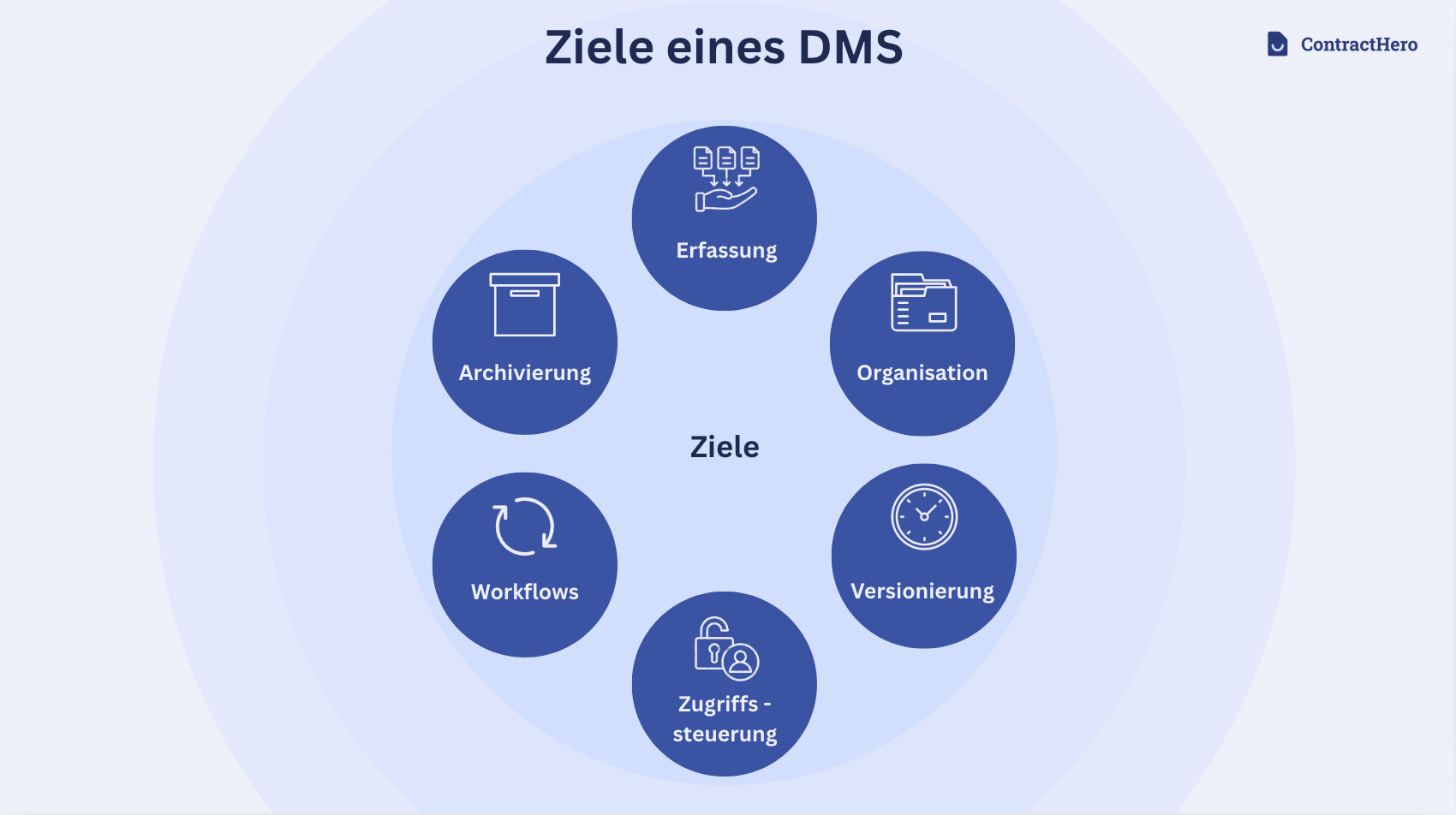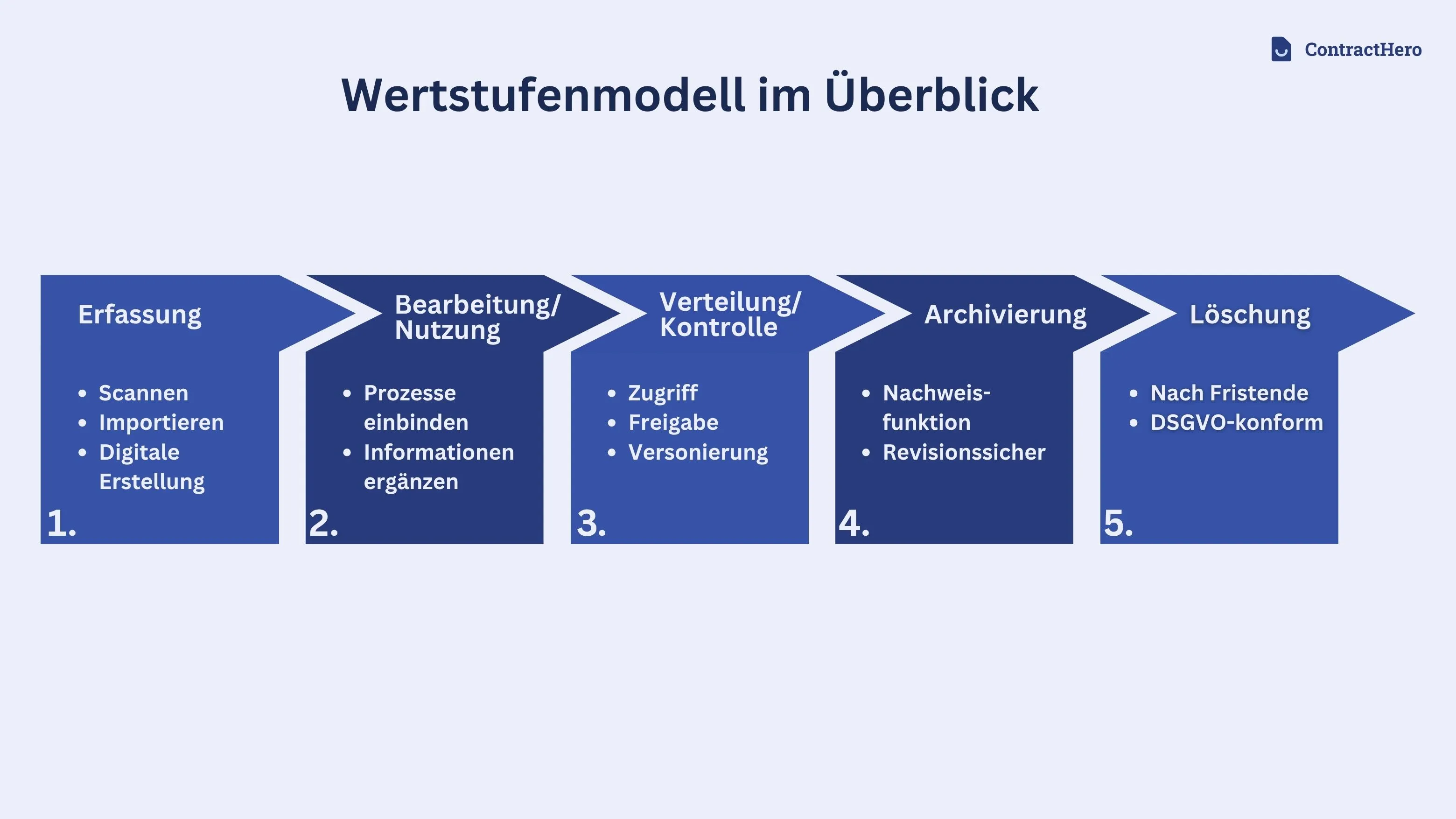.jpg)
Large quantities of documents are created every day in day-to-day business - both digital and analog. Contracts, invoices and minutes often contain business-critical information that needs to be systematically managed and archived in a legally compliant manner. Professional document management ensures clear processes, transparent structures and reliable availability of relevant documents.
Document management refers to the systematic organization, storage and management of documents in a company. The aim is to structure physical and digital documents in such a way that they can be accessed quickly and easily. The aim is to optimize work processes, increase efficiency and clearly assign information. At the heart of document management is the ability to manage all company-relevant documents in a structured and clear manner, regardless of the medium. Structured document management provides an overview, reduces sources of error and makes it easier to comply with internal and external regulations, especially in dynamic and highly regulated working environments such as the healthcare sector, the financial sector or public authorities.
Document management takes on a number of clearly defined tasks in order to control documents reliably and manage them in a legally compliant manner:
Digitaldocument management is a database-supported, specialized software solution for the secure management of electronic documents. It supports companies in replacing paper-based processes and making information clear, organized and permanently available.
The focus is on document management systems (DMS): these store digital files centrally in a cloud, make them easy to find and make them available to authorized persons, regardless of their location. This turns analog document management into a strategic digital tool for transparent processes, legally compliant archiving and a smooth flow of information within the company.
A document management system (DMS) consists of several central components that together enable structured, secure and traceable document management.
The focus is on linking each document with so-called metadata - i.e. additional information such as creation date, document type, author or responsibility. This combination is stored centrally as a unit and forms the basis for an intelligent search function and automated processes.
Documents enter the DMS via various channels: by scan, direct upload, email or via interfaces to other systems such as ERP, accounting or CRM software. After receipt, they are indexed - i.e. tagged with relevant keywords that make subsequent searches much easier.
Another key component is versioning: every change to a document is automatically documented. Earlier versions are retained and can be viewed or restored if required. This creates a complete history that ensures transparency and traceability.

For a document management system (DMS) to offer real added value in day-to-day work, it should be possible to connect it to programs that are regularly used in the company. While sales teams generally work with CRM systems such as Salesforce, ERP solutions are primarily central to production and administration. A well-integrated DMS solution ensures that information flows smoothly between these systems and remains available in a central location.
When relevant messages and documents are automatically recorded and systematically archived, important information is no longer lost in personal mailboxes. Instead, it can be found by all authorized persons and is centrally available.
This not only improves collaboration, but also ensures that knowledge remains accessible within the company. Integration into existing processes thus creates the basis for reliable information flows and smooth workflows in everyday digital working life.
Example: If an invoice is received by email, it can be automatically saved in the DMS, assigned to the appropriate process and transferred directly to the approval process - without any manual forwarding or filing.
Legal security ensures that documents are not only available, but also traceable, verifiable and protected against manipulation. This applies not only to storage, but also to the entire handling of information - from creation and processing to archiving and deletion.
How documents are stored is particularly important. They must be available even after many years, tamper-proof and fully verifiable if required.
For this to succeed, clearly defined responsibilities, regulated access rights and seamless change logs are required. Legal certainty is always created when it is clearly defined who created, edited or approved a document and when this was done.
Digital signatures, audit-proof archiving and defined retention periods help to manage documents in a legally effective, auditable and permanently secure manner.
Companies are legally obliged to retain business documents for certain periods of time. The deadlines are based on the German Commercial Code (HGB) and the German Fiscal Code (AO), among others.
The following requirements will apply from 2025:
The cut-off date for the retention period is the end of the calendar year in which the document was created. Premature deletion is not permitted. In many cases, it even makes sense to keep documents beyond the minimum period, for example in the case of industry-specific audit obligations or tax uncertainties.
A digital signature ensures that a document can no longer be changed after it has been signed. It confirms the identity of the person signing and makes the content legally traceable. This is particularly important for contracts, offers or minutes to ensure that they are binding and verifiable.
Revision security means that documents are stored completely, unalterably and transparently. Changes are logged, older versions are retained and access is clearly regulated.
Together, digital signatures and audit-proof archiving ensure that documents are protected against manipulation, legal requirements are met and content remains verifiable in the long term.
Procedural instructions and guidelines are central components of a structured document organization. Guidelines provide the general framework - they define which objectives are to be achieved or which rules apply (e.g. data protection, retention obligations).
Procedural instructions, on the other hand, describe very specifically how certain processes are to be carried out in the company - step by step.
In document management, both ensure that all employees work according to the same rules, that responsibilities are clear and that legal and internal guidelines are adhered to.
As described above, a procedural instruction comprises a binding description of certain processes in the company. It specifies which steps are necessary, who is responsible, which resources are required and which requirements must be met.
In contrast to general guidelines, it describes the process precisely and clearly. This means that tasks can be completed in a uniform manner - regardless of who is working on them or at which location.
Process instructions are part of quality management and are regulated by various international standards. ISO 9001, which specifies the basic requirements for documented processes, is particularly relevant.
Typical contents are
Companies in Germany and the EU are subject to clear legal requirements for digital document management. The GoBD for Germany and the GDPR at European Union level are particularly important here.
The GoBD stipulates how tax-relevant documents must be stored completely, unalterably and verifiably. For example, changes to documents must be fully documented and the original version must remain available at all times.
The GDPR regulates the protection of personal data. Among other things, this directive states that companies must ensure that only authorized persons have access to sensitive content and that defined deletion periods are observed.
In addition, a DMS must also comply with more recent legal requirements, such as the obligation to process invoices electronically, as well as industry-specific regulations, such as in the financial or healthcare sectors.
The requirements for accessible digital documents are also increasing, particularly in the public sector or for services with a wide range of users. The aim here is to prepare content in such a way that it is also accessible to people with disabilities, for example through screen reader-compatible PDF files.
The value level model describes the life cycle of a document and assigns a business value to it depending on the phase. This makes it clear how a document should be systematically managed from the first draft to deletion.
The first step is to capture the data, either digitally or by scanning. At this stage, the business value is still low. The relevance of the document increases with further processing: Information is added, checked and actively integrated into processes. As soon as a document is distributed and versioned, it influences operational decisions. This is where its business value reaches its peak.
Archiving follows active use. In this phase, the document is primarily used as legal or organizational evidence, such as for audits, contracts or internal accountability obligations. If there is no longer a legal or company retention obligation, the document is deleted in accordance with data protection regulations.
The value level model helps to make targeted use of resources: Important documents are prioritized, while less relevant ones are relegated to the background, reducing storage space, search times and administrative effort. This allows employees to find exactly the information they need more quickly. At the same time, it supports compliance with legal requirements regarding retention obligations and data protection.

Digital document management is much more than just filing files - it creates structure, reduces manual effort and ensures that companies reliably comply with legal requirements. A powerful DMS supports central storage, quick retrieval, controlled access management and seamless versioning of documents - across the entire life cycle.
Although document management systems already provide a good basis, specialized contract management software such as ContractHero comes into play precisely where DMS reach their limits.
ContractHero offers comprehensive solutions: With German server security and ISO certification, we guarantee the highest standards. Our user roles enable clear structuring and multi-client capability. Document capture is supported by OCR and AI technologies, while tasks and reminders can be created both manually and automatically. We also offer numerous integrations, APIs and webhooks to ensure seamless connections to other systems. Our contract creation and template management features complete our offering, so you benefit from a holistic DMS solution.